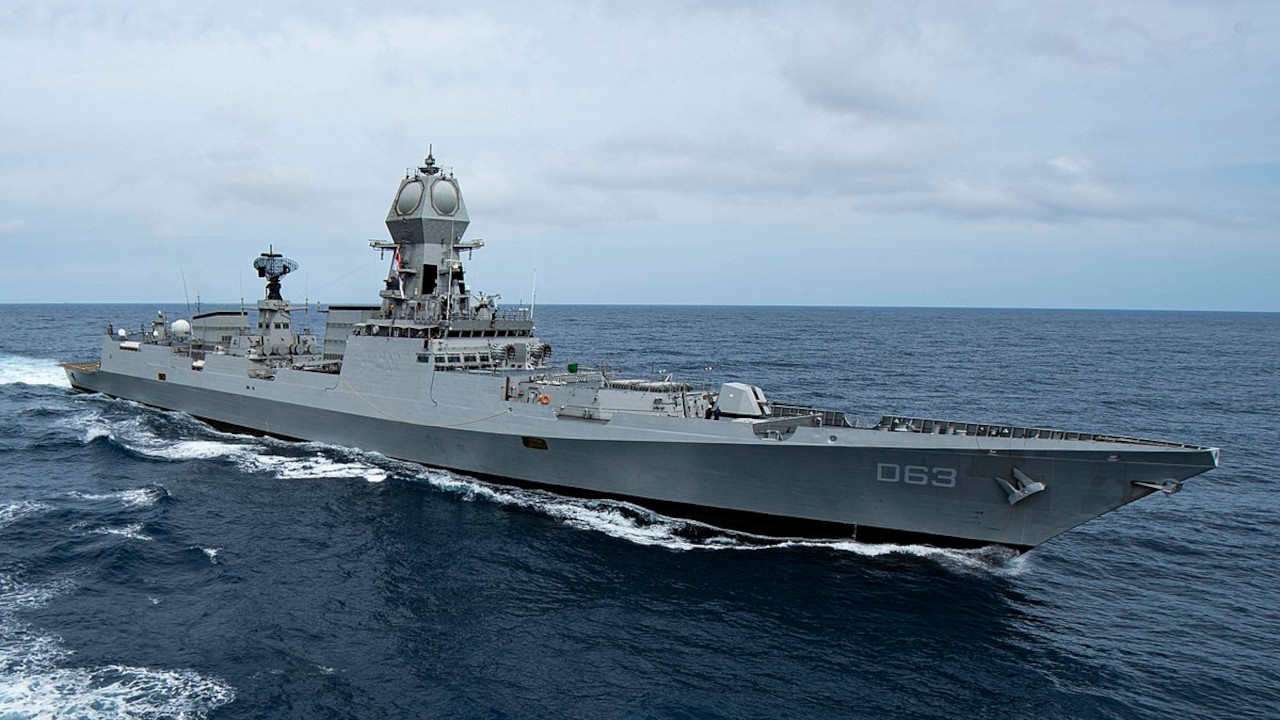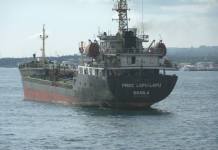It has been a hyperactive schedule for the Indian Navy over the last week – Indian Naval Commanders’ Conference, India-Australia bilateral naval exercise, International Fleet Review in Japan, and Malabar Naval Edition involving the Quad navies. And all this is being seen as contributing to the Indo-Pacific’s stability.
Immediately after the great International Fleet review that Japan hosted on November 6 at Sagami Bay, four Quad partners – Australia, India, Japan, and the United States – will commence the Malabar naval exercise off Yokosuka on Tuesday (November 8). This exercise will conclude on November 18.
The Navy chiefs of the four Quad countries met in Tokyo on November 5. They exchanged views on “further enhancing inter-operability” in future editions of the Malabar multilateral naval exercise.
The timing of both the IFR and Malabar exercise is significant, coming as they do in the wake of China’s increasing aggressiveness in the Indo-Pacific and North Korea firing record numbers of missiles.
Incidentally, the IFR marked the 70th anniversary of Japan’s Maritime Self-Defense Force (MSDF) founding. Around 40 warships from 13 countries came together in Sagami Bay, off Tokyo.
The naval parade involved 38 vessels, 18 from friendly countries such as the United States, South Korea, Britain, Australia, Singapore, India, and Thailand. Thirty-three aircraft flew overhead, including submarine-hunting patrol planes and helicopters. India’s two frontline warships, INS Shivalik and INS Kamorta were in this parade.
Overseeing the parade, Japanese Prime Minister Fumio Kishida said that Japan and like-minded nations must be prepared for situations in which “some countries trample on the peace and security of others through the use or threat of force.”
In a speech aboard the MSDF helicopter carrier Izumo, Kishida reiterated Tokyo’s plans to “fundamentally strengthen” Japan’s defense capabilities within five years.
His assertion that “unilateral attempts to change the status quo by force, such as the recent invasion of Ukraine, must never be tolerated in any region of the world” is also aimed at China, which is threatening to take over Taiwan Kishida forcibly and is staking territorial claims on the Japanese islands in the East China Sea.
However, it should be noted that the IFR, by its nature, is a symbolic and friendly gesture in which the host countries invite even the navies of the countries with which it has adversarial relations.
In this context, it was significant that China declined the Japanese invitation to send its vessels to the IFR. And equally substantial was Japan’s withdrawal of its invitation to Russia for its invasion of Ukraine.
It was clear that by hosting the IFR, Japan signaled that it is firmly committed to the vision of a Free and Open Indo-Pacific. Tokyo would like the international community to cement trust in its Self-Defense Forces as a proactive, reliable security partner, particularly in the maritime domain, where the power balance appears to be shifting toward China’s advantage of late.
That explains why Japan now consistently sends MSDF ships to similar events overseas, dispatches forces for engagements under its Indo-Pacific Deployment operations, and is one of the biggest supporters of exercises hosted by organizations such as the Western Pacific Naval Symposium, ASEAN Regional Forum, and ASEAN Defense Ministers Meeting Plus.

QUAD At The Malabar Military Drills
In contrast, however, the Malabar exercise is a proper military exercise. Over the next ten days, it will see the four Quad navies in action. Reportedly, the exercise will witness “high-tempo” drills in multiple domains and complex surface, sub-surface, and air operations, including live firing drills.
Apart from the ships (Shivalik and Kamotra), the Indian Navy is deploying other naval assets, including P-8I long-range maritime reconnaissance and anti-submarine warfare aircraft, in this exercise.
It may be noted that INS Shivalik is a multi-role guided missile stealth frigate, and INS Kamorta is an anti-submarine corvette. Both of them are indigenously produced, reflecting thus the growing capability of India to build its warships. And both of them are part of the Indian Navy’s Eastern Fleet based at Visakhapatnam.
Incidentally, this will be the 26th edition of the Malabar naval exercise. It started in 1992 as a bilateral drill between the Indian Navy and the US Navy in the Indian Ocean. Japan became a permanent member of the exercise in 2015. And Australia joined in 2020. It is an annual war game taking place in various parts of the Indo-Pacific.
Unmistakably, the continuous rise of the Chinese Navy (PLA Navy) in the Indo-Pacific binds all four countries in joining hands and bringing their armed forces together to develop joint strategies through military exercises. In the maritime domain, it is realized that they must act in unison individually; it is becoming tough to catch up with China’s growing naval prowess.
According to the World Directory of Modern Military Warships (2022), China now ranks second after the United States on the Global Naval Powers Ranking 2022 (India ranks seventh). China also has the largest number of major surface combatants of any navy globally, with an overall battle force of approximately 350 surface ships and submarines. The rate of its annual addition of naval vessels and frigates is the highest in the world.
This policy of acting together by the Quad partners, all concerned over the growing hegemony of China in the Indo-Pacific, was also manifested last week, with India and Australia conducting a bilateral maritime exercise off the Indian coast of Visakhapatnam in the Bay of Bengal.
Australia’s flagship regional engagement activity, Indo-Pacific Endeavour (IPE), arrived in Visakhapatnam on October 30. It comprised two ships (HMAS Adelaide and Anzac), helicopters, and 1,500 personnel. The Indian contingent in the exercise included INS Ships Jalashwa and Kavaratti. The exercise concluded on November 5.
Terming India and Australia as the guardians of the flanks of the Indian Ocean, visiting Australian Navy Fleet Commander Rear Admiral Jonathan Earley said that since the Indo-Pacific is marked by the ongoing “big power muscle movement,” it is vital that India and Australia must train together to build trust and confidence while stressing on Maritime Domain Awareness (MDA) for the region.
He said good progress had been made on MDA and the exchange of information on the movement of military vessels in the region, a growing area of cooperation among the Quad countries. “There is an opportunity for that to grow in more classified domains.
That is ongoing… The enthusiasm and the motivation to share more are certainly there,” Earley added, adding that expanding surveillance in the P-8I maritime patrol aircraft and India’s recent acquisition of MH-60R helicopters build commonality.
He highlighted how the Quad countries have several common military platforms, with India acquiring more and more military hardware from the US. “The recent reciprocal exchange of P-8 aircraft exercises between the two countries had gone “exceptionally well,” said the Australian Admiral.
India’s Shifting Focus From Land To Maritime Power
Incidentally, the Indo-Australian exercise was taking place during India’s second Naval Commanders’ Conference in New Delhi (October 31 to November 3), which, among other challenges in the Indian Ocean region, is of vital concern to India, did focus on Chinese maritime activities.

The conference, addressed by India’s defense minister Rajnath Singh, new Chief of defense staff (CDS) General Anil Chauhan, and the Navy Chief Admiral Hari Kumar, focused on how the Indian Navy would remain “a combat-ready, credible, cohesive, and future-proof force.”
Admiral Hari Kumar is on record to have stated that China remains a formidable challenge and has increased its presence not only along India’s land borders but also in the maritime domain by leveraging anti-piracy operations to normalize its naval presence in the Indian Ocean Region (IOR).
“At any point, we have anything between five to eight Chinese Navy units, be it warships or research vessels, and a host of Chinese fishing vessels operating in the IOR. We keep an eye on them and see how they are undertaking their activities in the IOR”, according to the Indian Navy Chief.
The IOR, which includes the Middle East, the eastern coast of Africa, South Asia, and Southeast Asia, is a significant region of interest for the Indian Navy. More than 70% of the country’s imports and exports pass through sea lanes in this region. Therefore, the growing Chinese naval presence in the IOR seriously threatens India’s vital security interests.
In recent years, Indian strategic planners have rediscovered the importance of maritime power for the country’s security. Empires have risen and fallen as they lost command of the seas, whether the Persian, Napoleon, or Great Britain.
India was a global player as long as it had maritime interactions from Zanzibar off the coast of Africa to the shores of the Arabian Peninsula, all the way through the Andaman Sea to the mainland and islands of SouthEast Asia through people, faiths, ideas, mythologies, art, architecture and goods. India’s decline started when it became land-centric under the Mughal rule.
Even after independence in 1947, because of the wars with China and Pakistan, this land-centric or the “continentality-mindset” prevailed, with the Indian Navy getting scant attention in the security outlook.
Interestingly, China, like India, also had this continentality – mindset not long ago. But China now has become a foremost maritime power. Therefore, India’s stand is also shifting, as Admiral Arun Prakash, a former Indian Navy Chief, says, from pure ‘Continentality’ to the requisite mix of ‘Continentality-Maritimity.’
Accordingly, the Indian Navy is also growing. As Admiral Hari Kumar highlighted during the Naval Commanders’ conference, the Indian Navy has been strengthened by the recent commissioning of the second carrier INS Vikrant, acquiring of more missile power, two ALH squadrons, and the launch of platforms like Surat, Udaygiri, Dunagiri, Nistar, Nipun, and Nirdeshak.
He further pointed out that the maiden concurrent deployment of Indian Navy ships across six continents on August 15 this year served as valuable signaling to underscore India’s credibility – at home, in the region, and worldwide.
In the last six months, operational deployments have also emphasized India’s credibility, with a footprint covering all major oceans of the world, he added.
All this is said to be India’s signal that it will challenge China’s hegemonistic activities in the Indo-Pacific and the IOR in particular. And in this, India is not alone. India has solid support from Australia, Japan, and the United States in maintaining a rules-based order in the Indo-Pacific.
- Author and veteran journalist Prakash Nanda has been commenting on politics, foreign policy on strategic affairs for nearly three decades. A former National Fellow of the Indian Council for Historical Research and recipient of the Seoul Peace Prize Scholarship, he is also a Distinguished Fellow at the Institute of Peace and Conflict Studies.
- CONTACT: prakash.nanda (at)hotmail.com
- Follow EurAsian Times on Google News





